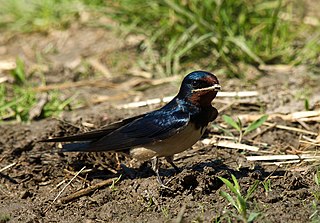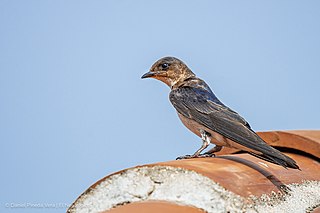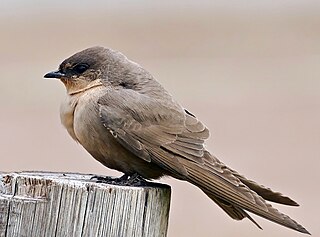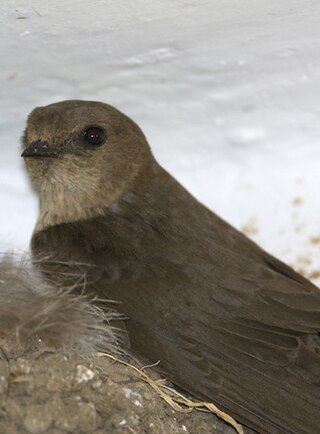
The swallows, martins, and saw-wings, or Hirundinidae are a family of passerine songbirds found around the world on all continents, including occasionally in Antarctica. Highly adapted to aerial feeding, they have a distinctive appearance. The term "swallow" is used as the common name for Hirundo rustica in the UK and Ireland. Around 90 species of Hirundinidae are known, divided into 21 genera, with the greatest diversity found in Africa, which is also thought to be where they evolved as hole-nesters. They also occur on a number of oceanic islands. A number of European and North American species are long-distance migrants; by contrast, the West and South African swallows are nonmigratory.

The Eurasian crag martin or just crag martin is a small passerine bird in the swallow family. It is about 14 cm (5.5 in) long with ash-brown upperparts and paler underparts, and a short, square tail that has distinctive white patches on most of its feathers. It breeds in the mountains of southern Europe, northwestern Africa and across the Palearctic. It can be confused with the three other species in its genus, but is larger with brighter tail spots and different plumage tone. Many European birds are resident, but some northern populations and most Asian breeders are migratory, wintering in northern Africa, the Middle East or India.

The European red-rumped swallow is a small passerine bird in the swallow family Hirundinidae. It breeds in open hilly country of southern Europe and north Africa east to Iran, Pakistan and northwest India. During winter it migrates to Africa and southwest Asia. It was formerly considered to be a subspecies of the eastern red-rumped swallow.

The mosque swallow is a large species of swallow. It is a resident breeder in much of sub-Saharan Africa, although most common in the west. It does not migrate but follows the rains to some extent.

The bird genus Hirundo is a group of passerines in the family Hirundinidae. The genus name is Latin for a swallow. These are the typical swallows, including the widespread barn swallow. Many of this group have blue backs, red on the face and sometimes the rump or nape, and whitish or rufous underparts. With fifteen species this genus is the largest in its family.

The grey-breasted martin is a large swallow from Central and South America.

The river martins form a distinctive subfamily Pseudochelidoninae within the swallow and martin bird family Hirundinidae. The two species are the African river martin Pseudochelidon eurystomina, found in the Congo and Gabon, and the white-eyed river martin Pseudochelidon sirintarae, known only from one site in Thailand. These are medium-sized, largely black swallows that have a light buoyant flight and feed on insects caught in the air. They appear to be more terrestrial than other swallows, frequently walking rather than perching, and the white-eyed may be crepuscular. The African species excavates nest holes in sandy ridges in rivers, while the breeding locations and habits of the Asian bird are unknown.

Progne is a genus of passerine birds in the swallow family Hirundinidae. The species are found in the New World and all have "martin" in their common name.

The mangrove swallow is a passerine bird in the swallow family that breeds in coastal regions from Mexico through Central America to Panama. It has blue-green upperparts, blackish flight feathers, a white rump, a black tail, and white underparts. It can be identified by the supraloral white streak, the white line near its eye, which only occurs in two other species of Tachycineta: the violet-green swallow and the white-rumped swallow. The sexes, although similar in plumage, differ slightly in size. The juveniles have grey-brown upperparts and white-washed underparts. This swallow's song is generally described as a soft trilling, with a rolled jeerrt call, and a sharp alarm note.

The eastern red-rumped swallow is a small passerine bird in the swallow family Hirundinidae. It is found in open, often hilly, areas with clearings and cultivation across Southeast Asia to north-eastern India and Taiwan.

The dusky crag martin is a small passerine bird in the swallow family. It is about 13 cm (5 in) long with a broad body and wings, and a short square tail that has small white patches near the tips of most of its feathers. This martin has sooty-brown upperparts and slightly paler underparts. The two subspecies are resident breeding birds in South Asia from the Indian subcontinent to southwestern China and the northern parts of Thailand, Vietnam and Laos.

The greater striped swallow is a large swallow that is native to Africa south of the equator.

The rock martin is a small passerine bird in the swallow family that is resident in central and southern Africa. It breeds mainly in the mountains, but also at lower altitudes, especially in rocky areas and around towns, and, unlike most swallows, it is often found far from water. It is 12–15 cm (4.7–5.9 in) long, with mainly brown plumage, paler-toned on the upper breast and underwing coverts, and with white "windows" on the spread tail in flight. The sexes are similar in appearance, but juveniles have pale fringes to the upperparts and flight feathers. The former northern subspecies are smaller, paler, and whiter-throated than southern African forms, and are now usually split as a separate species, the pale crag martin. The rock martin hunts along cliff faces for flying insects using a slow flight with much gliding. Its call is a soft twitter.

The crag martins are four species of small passerine birds in the genus Ptyonoprogne of the swallow family. They are the Eurasian crag martin (P. rupestris), the pale crag martin (P. obsoleta), the rock martin (P. fuligula) and the dusky crag martin (P. concolor). They are closely related to each other, and have formerly sometimes been considered to be one species. They are closely related to the Hirundo barn swallows and are placed in that genus by some authorities. These are small swallows with brown upperparts, paler underparts without a breast band, and a square tail with white patches. They can be distinguished from each other on size, the colour shade of the upperparts and underparts, and minor plumage details like throat colour. They resemble the sand martin, but are darker below, and lack a breast band.

Delichon is a small genus of passerine birds that belongs to the swallow family and contains four species called house martins. These are chunky, bull-headed and short-tailed birds, blackish-blue above with a contrasting white rump, and with white or grey underparts. They have feathering on the toes and tarsi that is characteristic of this genus. The house martins are closely related to other swallows that build mud nests, particularly the Hirundo barn swallows. They breed only in Europe, Asia and the mountains of North Africa. Three species, the common, Siberian and Asian house martins, migrate south in winter, while the Nepal house martin is resident in the Himalayas year-round.

The African river martin is a passerine bird, one of two members of the river martin subfamily of the swallow family, Hirundinidae. When discovered, it was not initially recognised as a swallow, and its structural differences from most of its relatives, including its stout bill and robust legs and feet, have led to its current placement in a separate subfamily shared only with the Asian white-eyed river martin. The African river martin is a large swallow, mainly black with a blue-green gloss to the head and a greener tint to the back and wings. The under-wings are brownish, the underparts are purple-black, and the flight feathers are black. This martin has red eyes, a broad orange-red bill and a black, square tail. Young birds are similar in appearance to the adults, but have browner plumage. This species has a variety of unmusical calls, and displays both in flight and on the ground, although the purpose of the terrestrial display is unknown.

The pied-winged swallow is a species of bird in the family Hirundinidae. It has distinctive steel-blue upperparts with white wing patches. It is native to parts of West Africa.

The pale crag martin is a small passerine bird in the swallow family that is resident in Northern Africa and in Southwestern Asia, east to Pakistan. It breeds mainly in the mountains, but also at lower altitudes, especially in rocky areas and around towns. Unlike most swallows, it is often found far from water. It is 12–13 cm long, with mainly brown plumage, paler-toned on the upper breast and underwing coverts, and with white "windows" on the spread tail in flight. The sexes are similar in appearance, but juveniles have pale fringes to the upperparts and flight feathers. It was formerly considered to be the northern subspecies of the rock martin of southern Africa, although it is smaller, paler, and whiter-throated than that species. The pale crag martin hunts along cliff faces for flying insects using a slow flight with much gliding. Its call is a soft twitter.

The Mascarene martin or Mascarene swallow is a passerine bird in the swallow family that breeds in Madagascar and in the Mascarene Islands. The nominate subspecies occurs on Mauritius and Réunion and has never been found away from the Mascarene Islands, but the smaller Madagascan subspecies, P. b. madagascariensis, is migratory and has been recorded wintering in East Africa or wandering to other Indian Ocean islands.

Brazza's martin is a passerine bird in the swallow family, Hirundinidae. It is 12 centimeters (4.7 in) long with grey-brown upperparts, heavily black-streaked white underparts, and a brownish tint to the breast plumage. The sexes are similar, but juvenile birds have more diffuse breast streaking and reddish-brown edges to the feathers of the back and wings. The song consists of a series of short notes of increasing frequency, followed by a complex buzz that is sometimes completed by a number of clicks.


























